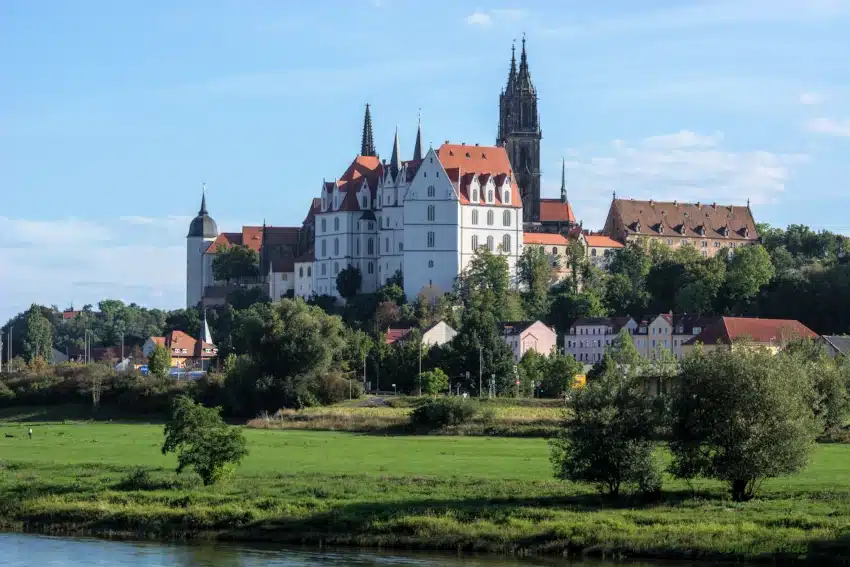
The Saxon city of Meissen is inextricably linked with the white gold, porcelain. Since the decree of the Elector Augustus the Strong, European porcelain was produced in Meissen for the first time from 1710. But the porcelain city on the Elbe river has much more to offer than just white tableware. Anyone approaching Meissen in the Elbe Valley will see the impressive cathedral rock with the Albrechtsburg castle and the distinctive double towers of the cathedral from afar. This article is intended to offer some tips for visiting Meißen.
Meißen – Founding place of Saxony over 1000 years ago
The city of Meissen has a long history of almost 1100 years. Maybe even much longer. Because when the East Franconian King Henry I „the Vogler“ had his fortress built on the castle hill in 929, there was already a Slavic village called Meisa at the foot of the hill. The construction of the castle is also considered to be the founding event for the state of Saxony, which has existed since then in different state constitutions – sometimes as an electorate, sometimes as a kingdom or even as a republic – thus also almost 1100 years.
Missionary work in the Meissen region
The king was followed by the church – from 968 Meissen is the seat of the eponymous bishopric. In the following period, several monasteries were founded – a Benedictine convent, from 1205 the Augustinian canons‘ monastery St.Afra as well as a little outside north in the Elbe valley the monastery Zum heiligen Kreuz (The holy cross) of the Cistercian nuns towards the end of the 12th century. The Franciscan order was also represented with a custody for its province „Saxonia“ from 1263.
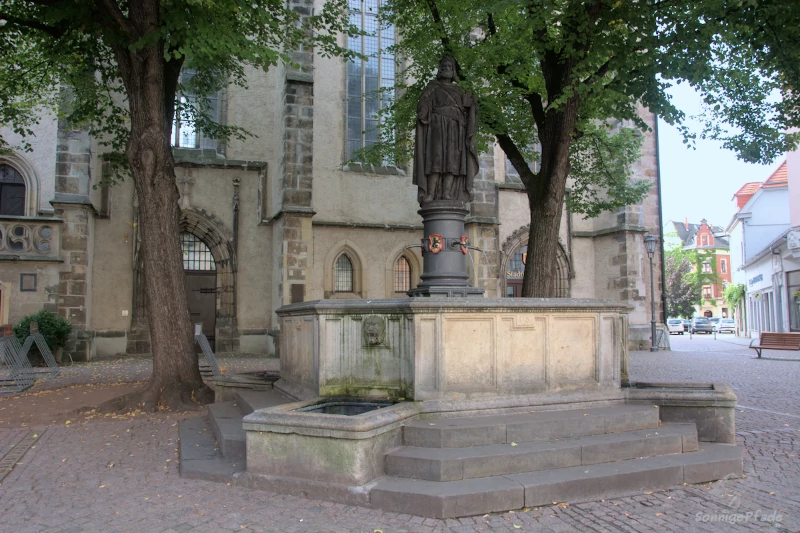
The construction of the cathedral on the castle hill began in 1250. In the course of time, the city of Meissen developed on the castle hill, the city charter is documented for 1323. From 1470, the Albrechtsburg Castle was built next to the Meissen Cathedral. It was built by Arnold of Westphalia, who, with Albrechtsburg Castle, did not create a castle as a fortress, but rather the first manor in the German-speaking world. But there is no real use for the building – Albrechtsburg Castle stands empty most of the time.
The city of Meissen first developed as a cloth-making city. The Clothmaker’s Gate behind the Church of Our Lady still bears witness to this. In 1539 the Reformation reaches Meissen. The monasteries were dissolved as a result. A city school moves into the Franciscan monastery. St.Afra becomes a „princely school“ (and is still an elite grammar school). The Thirty Years‘ War also leaves its traces in Meissen. Especially the cloth making loses its importance.
A new trade for Meissen – porcelain making
By decree ofthe saxon Elector Augustus the Strong, Meissen’s Albrechtsburg Castle became the seat of the Saxon Porcelain Manufactory in January 1710. More precisely, the „Royal Polish and Electoral Saxon Porcelain Manufactory“, because August the Strong was also King of Poland. Meissen is thus the first place where porcelain was produced in Europe. However, the technology was known in China long before. But the Saxon porcelain production was preceded by a real thriller.
As early as the beginning of the 1700s, a certain Johann Friedrich Böttger, an alchemist by trade, claimed to be able to produce gold. Augustus the Strong then had the cheeky quack imprisoned in Dresden’s Jungfernbastei and demanded a demonstration of his miraculous skills. Unfortunately, there was not much to the talk, and the goldsmith was threatened with being shortened by the length of his head. However, Walter von Tschirnhaus probably had a mercy and let Böttger participate in his own research on porcelain production. This stoneware was also very valuable at that time, because no one in Europe could produce it. With the invention of porcelain production, the alchemist Böttger managed to get his head out of the noose.
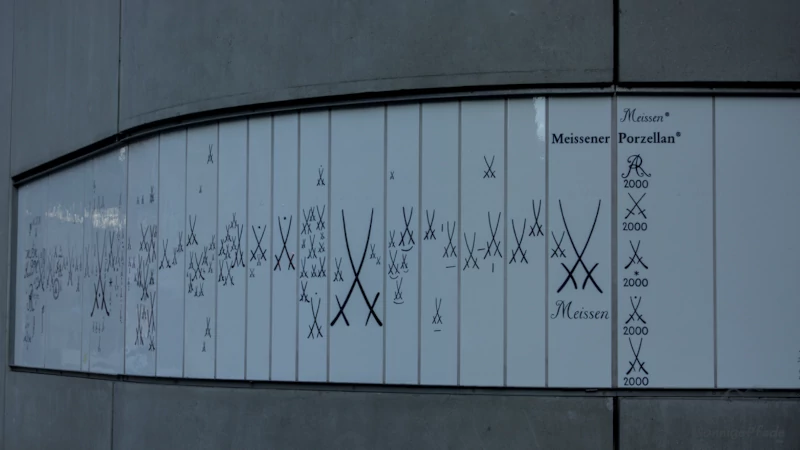
Porcelain from Albrechtsburg Castle
The choice of Albrechtsburg Castle as the first seat of the Royal Porcelain Manufactory in Meissen was also not accidental. This was not simply to breathe some life into an empty property, but rather the castle hill was considered to be reasonably safe and controllable. For one wanted to share the secret of porcelain production as little as possible and thus preserve the value of the white gold. Only a small circle of initiates knew the exact recipe, most of those involved only knew about fragments of porcelain production.
However, the secrecy succeeded only for about 8 years, then one of the insiders left for Vienna. Since 1718, porcelain was also produced in a Viennese manufactory.
By the way, the most important raw material for porcelain, the fine clay material kaolin, is mined in kaolin pits near Mügeln in northern Saxony.
Animal figures, sculptures and tableware for the Saxon court
From the very beginning, the porcelain manufactory’s list of goods included not only high-quality tableware, for which the Saxon court in Dresden and later also at Hubertusburg Castle in Wermsdorf had an immense demand. Sculptures and plastics were made from porcelain in Meissen, including statues and animal sculptures.

The decoration of porcelain tableware was done with the help of self-developed ceramic colors. Various decorative patterns such as foliage bands, animal motifs and ribbon work were developed. In addition, entire landscapes began to be depicted on porcelain.
Today, the porcelain manufactory is one of the places to go for curious Meissen visitors. In Meissen Talstraße next to the manufactory is the Porcelain Museum and a visitor center with the Museum of Meissen Art*. The modern building (2005) also houses a show workshop and an extensive collection. Historic Meissen porcelain from the times of August the Strong, i.e. shortly after the founding of the manufactory, can also be admired in the Dresden Zwinger. In Meissen, in addition to several exhibitions (at times also at Albrechtsburg Castle), there are examples of the city’s porcelain tradition everywhere in the streetscape, such as the Kändler Fountain at the Old Town Bridge or the carillon in the tower of the Church of Our Lady at the Market Square.
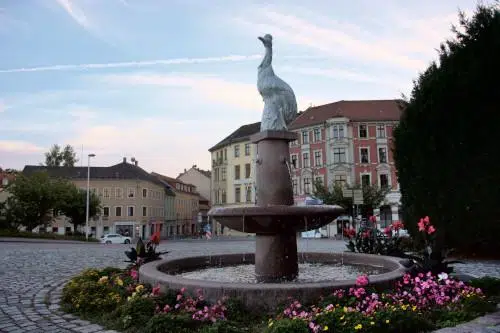
Walks in Meissen
The most interesting for visitors is the old town of Meissen, which is located on the left side of the river Elbe (i.e. on the west side). Despite two floods in 2002 and 2013, which surpassed all previous highs of the Elbe and affected large parts of the city, the old town with its small houses, stores, restaurants and artists‘ studios is a well-preserved gem. A large part of it is pedestrianized and traffic-calmed.
Heinrich Fountain and City Museum
From the Old Town Bridge it is only a few steps to Heinrich place with the Heinrich Fountain. This medieval market fountain is crowned by the figure of the city’s founder, Heinrich the I, and is overlooked by several shady trees.
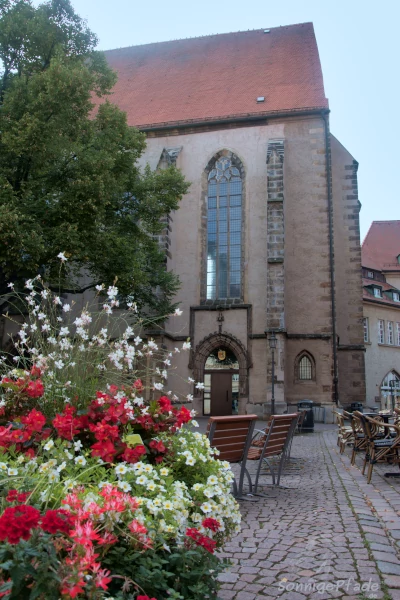
On the diagonal left, you pass the city museum in the former Franciscan monastery church of St. Peter and Paul in the direction of Roßmarkt. Behind the city library in the passage to the „Red School“ also hang porcelain tiles. However, these do not come from the Meissen manufactory, but have traveled far. They were made in the twin city of Arita-ćho in Japan, which also has a tradition in porcelain production. Meissen got the Japanese tiles on the occasion of the 25 – year town twinning with Arita cho.
At the Roßmarkt (horse market) there are remains of the old city wall, but quite unspectacular – simply as a piece of wall without towers, battlements or other accessories, which makes city walls in other cities always quite impressive.
But even here there are many old and handsome buildings from different eras, which altogether convey the long history of the city as a center of trade and crafts. From Roßmarkt it is only a few steps into Martinstraße and across the small river Triebisch to the historic pianoforte factory Thürmer. Today, in addition to an art and auction house, it houses a museum dedicated to the production of pianofortes in Meissen (Martin street 12).
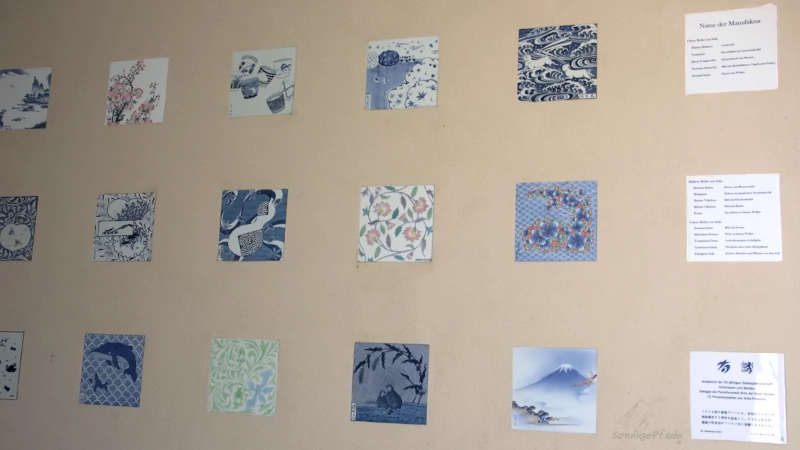
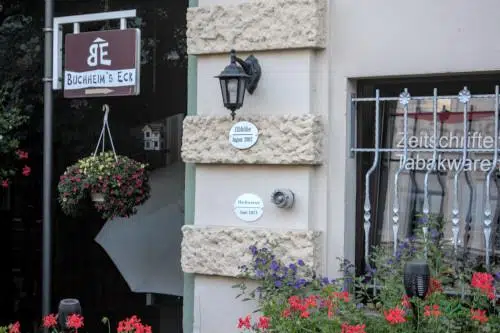
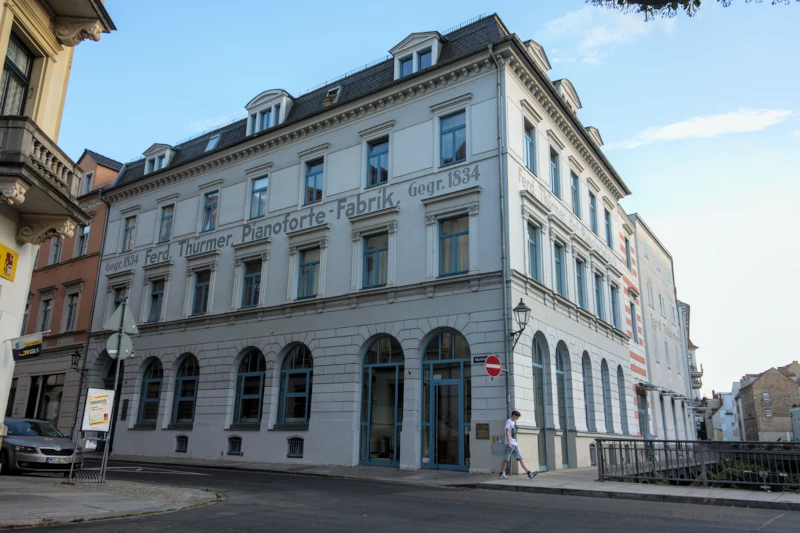
Market Square and church „Our dear women“
From Roßmarkt as well as from Heinrichplatz you can walk through other narrow streets of the old town to Meißen’s market place. The north side of the square is dominated by the Renaissance town hall with its balcony and sundial. On the southwest corner is the late Gothic church „Our dear women“, short Frauenkirche (Women church), with a porcelain carillon in the steeple. The carillon chimes briefly every quarter of an hour, and on the hour with a little melody. At the market is the tourist information of Meißen. Also the art association Meißen has – in the Burgstraße 2 – its domicile close to the market. Behind the Church of Our Lady stands the Clothmaker’s Gate and in Webergasse you can visit the Patrician House, a typical bourgeois residence of the Renaissance.
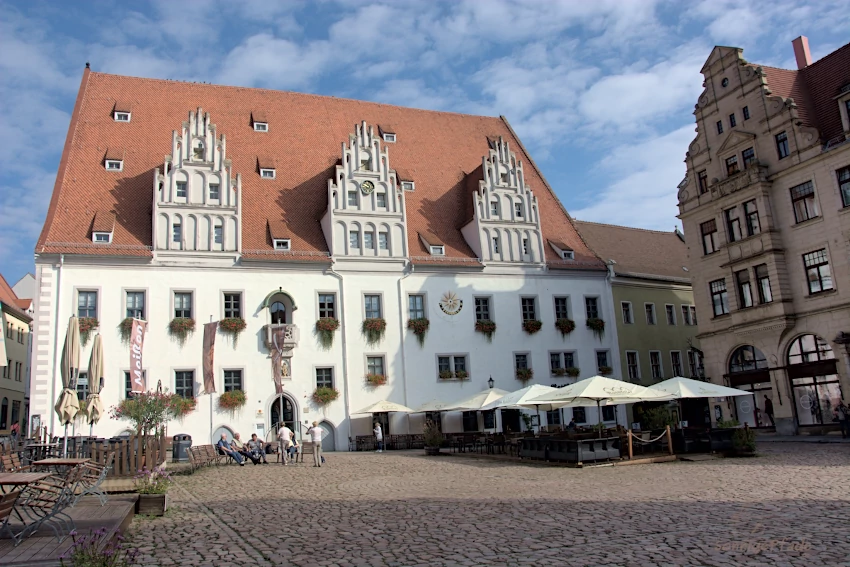
Several streets leave from the market, also a stair climb to the castle hill over the „Frauenstufen“ (women stairs) next to the Women church starts here. I decide to take Burgstraße, which still has a relatively moderate incline. At the end of the street rises steeply ahead the Burgberg with the impressive neo-Gothic towers of the Meissen Cathedral. In addition to restaurants, wine taverns and cafes, there are also small shops with artistic offers in this street. On the small square at the end, the paths branch out.
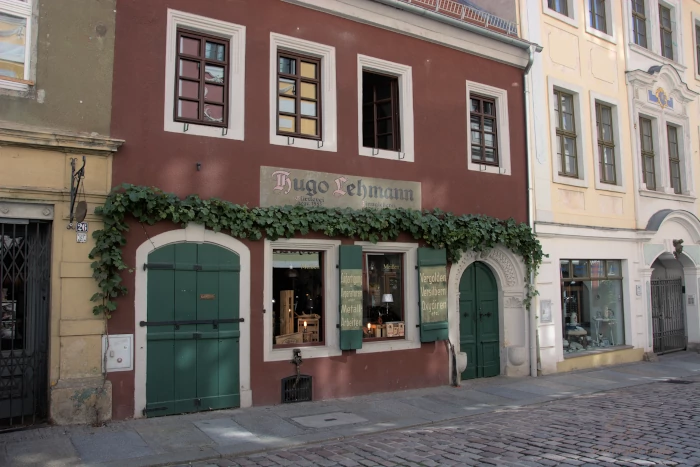
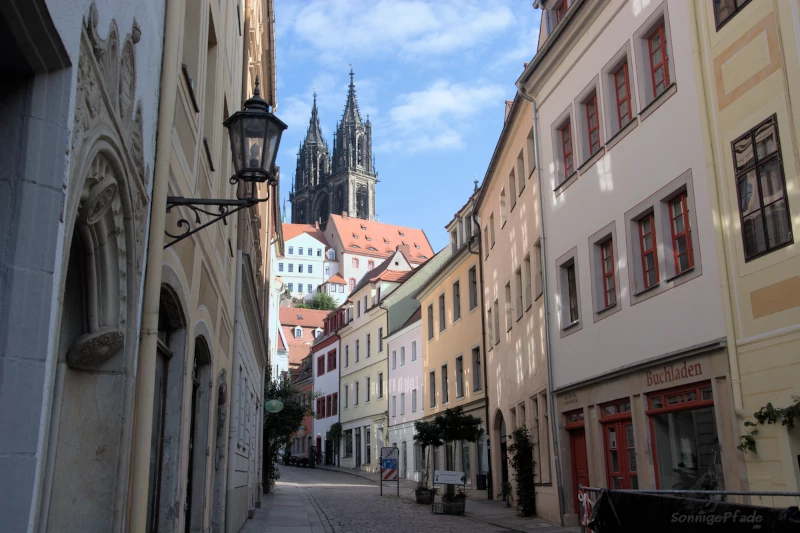
Many climbs to the castle hill
There are many ways to climb to the Albrechtburg – in serpentines around the mountain or over steep stairs, but also in a wide arc over narrow alleys and the „Freiheit“ (freedom). Since I’m not so „stair capable“ right now and also want to explore the surroundings of the castle more closely, I choose the Leinewebergasse, via which I ultimately come across the „Freiheit“.
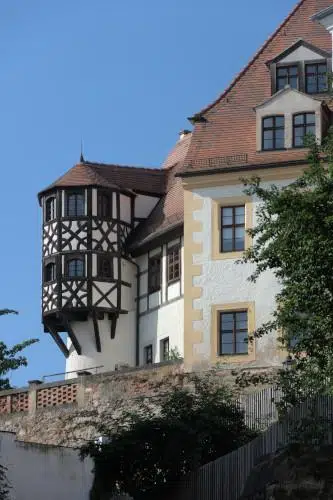
This is a street roughly parallel to the crest of the castle hill, on which various yards are located as well as the church of St. Afra and the St. Afra Gymnasium. Already during the ascent I can admire the half-timbered oriel on the courtyard Freiheit No.6. The house was built in 1346 and was formerly the Canons court. The parish estate of St. Afra is also a complex of buildings worth seeing.
Already before my journey to Meissen I had read about the „letters stone“ at the Freiheit 10, which is why I ‚fully savored‘ the Freiheit in search of the same. This former gate – keystone shows in squiggly lettering capital – letters. Possibly the initials of the former real estate owner. Depending upon fantasy and writing habits one is to find in the squiggles of the stone all letters of the alphabet again.
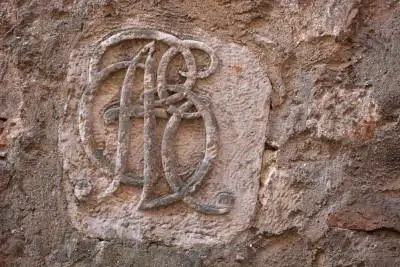
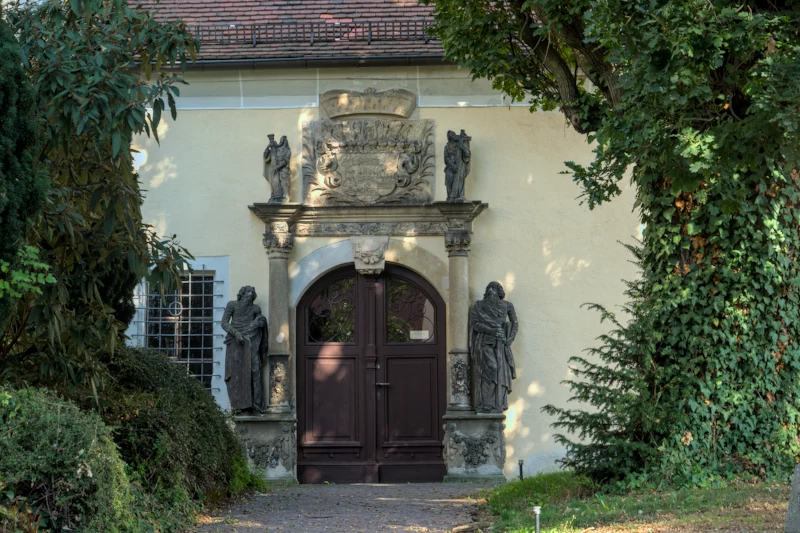
Albrechtsburg Castle and Meissen Cathedral
But back in the direction of Albrechtsburg and cathedral. I walk now on the freedom again in the opposite direction, past the St. Afra church and turn off at the Jahnaish yard, as it is probably already for hundred years at the wall indicated.
Gate houses for the „castle feeling“
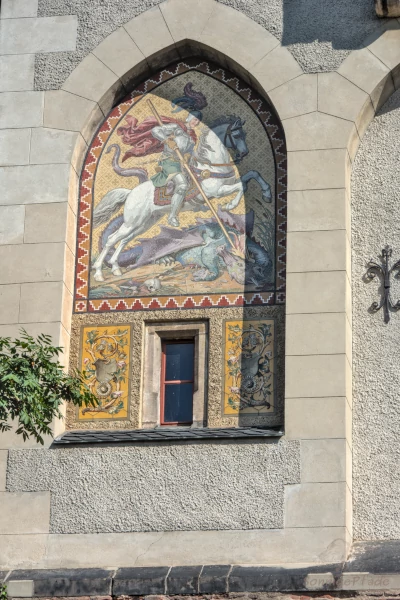
The narrow cobbled street apparently runs along the hillside and offers views of the roofs of Meissen’s old town over the partially crenellated wall. In the bright morning sun, the city glows on the slope that descends to the Triebisch and the Elbe river. Two gateways provide the appropriate backdrop for the castle entrance. The outer gate serves me immediately as a „picture frame“ for another castle and cathedral picture. At the middle castle gate mosaic pictures are attached, which show the dragon slayer St. George and the Evangelist John. An „inner castle gate“ does not seem to exist any more(?).
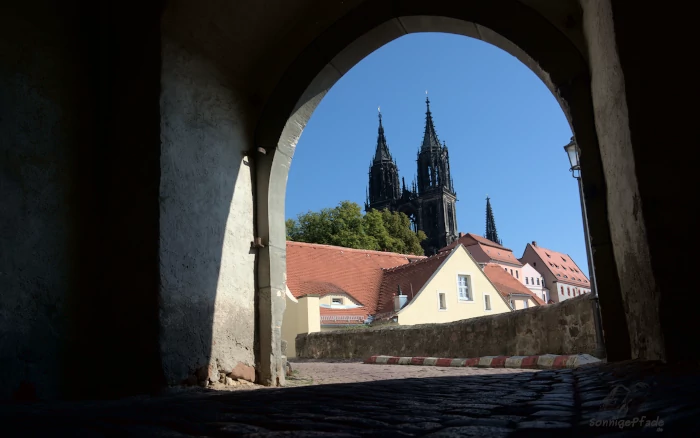
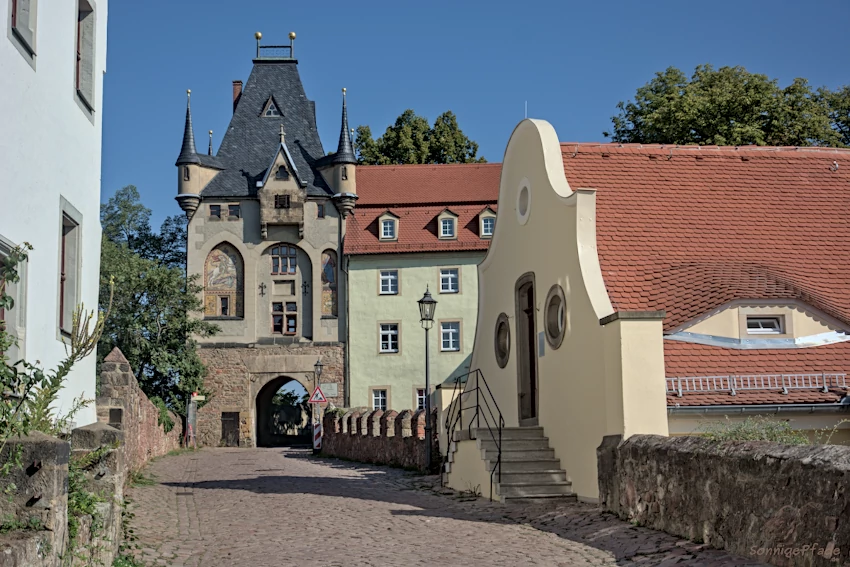
On the cathedral square
Once more around the corner and I stand on the cathedral square. In front of me rises the cathedral portal with the double towers that characterize the cityscape of Meissen. The spring stone in front of it commemorates the founding of the castle and the land of Saxony in 929 by Henry I, king of the East Frankish Empire. To the left of the cathedral is a shady square in the morning, at the end of which are the manor buildings of Albrechtsburg.
As already described, this was the first manor building ever and from 1710 also the first seat of the Meissen porcelain manufactory. Today the castle is a museum. On the north side of the cathedral square there is also the Kornhaus (granary) from 1494, which is still somewhat dormant. It was built as a granary and partly used as a stable for up to 80 horses. Later it was part of the production facilities of the first Meissen porcelain manufactory.
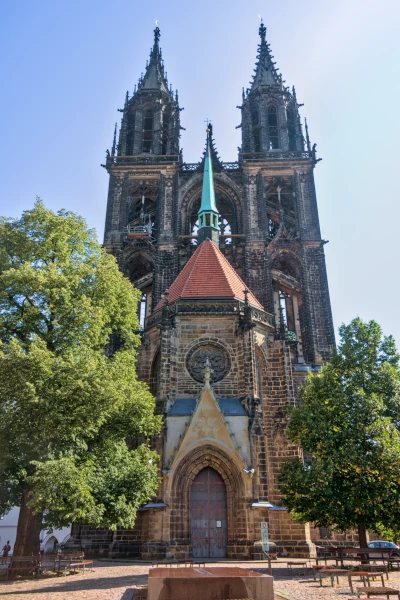
Past the cathedral on the right, on the edge of the plateau, are the Canon’s House and the district court. Today, the buildings on Cathedral square are also a hotel and restaurant, although the district court is still a courtroom. There is an exit to the city via a passage and again steep stairs, the Amtsstufen. From the courtyard of the district court, one can look over the valley wall down to the Elbe river, to the district of Cölln on the right bank of the Elbe, and far downstream into the Elbe valley with its vineyards.
The entrance to the cathedral is also located here on the south side next to the district court. The ticket office is located in the old cloister of the cathedral, which forms a small courtyard with the All Saints Chapel. Those who wish to visit both Albrechtsburg Manor and the cathedral can purchase a combination ticket for this purpose.
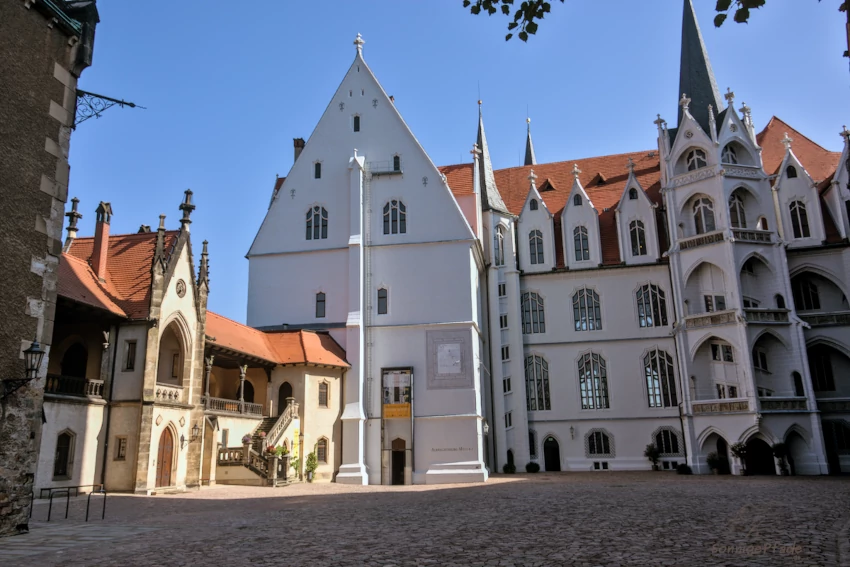
Many paths around the hill
If you are good on foot, you can walk on various paths around the castle hill – also along the hillside below the castle walls. This allows you to enjoy changing views of the city of Meissen, the Elbe River, the Elbe Valley and the surrounding hilly landscape.
However, if you have serious difficulties with the ascent, whether over one of the many stairs or over the serpentines of the street, you can now also reach the castle hill with the cathedral square via a panoramic elevator. However, this starts on the north side of the castle hill, facing away from the city, from Meisa street. There is a parking deck for visitors to Albrechtsburg Castle, which also offers parking spaces for the disabled.
A small intermediate – conclusion to the visit in Meißen
The porcelain city on the Elbe river is definitely worth at least one visit. A magnificent view of the Elbe valley, the old town of Meissen on the hillside and the castle hill with Albrechtsburg and cathedral speak for this. Many impressive houses steeped in history, the varied streets, the Franciscan and Women churches, the town hall, Freiheit…. all make a stroll through the city a journey through a long history.
A rich gastronomy provides the necessary refreshment and relaxation in between. A visit to the castle hill with the Albrechtsburg, a short devotion in the cathedral and, if the mood takes you, a visit to the castle museum are quasi indispensable Meissen „must haves„. The visitor center of the porcelain manufactory is certainly not only interesting for lovers of the white-colored dishes or figures and sculptures made of porcelain, but with the show workshop also for friends of crafts and technology.
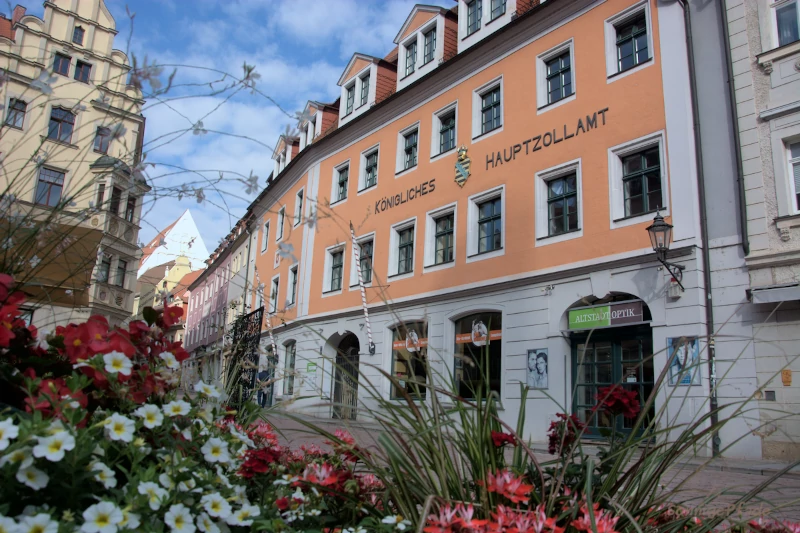
[Contains *advertisement]
Detour into East german rock music
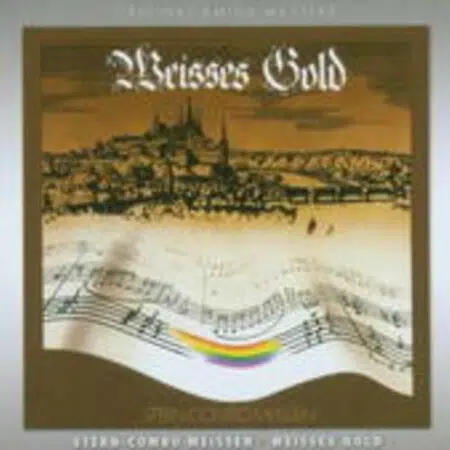
Especially in the 70s one of the most important bands of the GDR – rock history played in the city – the Sterncombo Meißen (later only Stern Meißen). The most famous LP of the Sterncombo is – how could it be otherwise – „Weisses Gold “ (white gold)*. In this concept album from 1978, which is assigned to the Art Rock, the legend of the gold maker Johann Friedrich Böttger, who finally can pull his head out of the noose with the porcelain – production, is processed musically.
Travel tips for Meissen
Museums in Meissen
- Albrechtsburg Already since 1881 museum. Exhibition „Architecture, Power and Porcelain“ – The castle and the history of Saxony (Open Mon-Sun 10 am – 6 pm; Nov – Feb 10 am – 5 pm)
- Meissen Cathedral Museum (Domplatz 7, Mon-Sun 9 a.m.-6 p.m.)
- Porcelain Museum in the Porcelain Manufactory „Museum of Meissen ART“ (Talstraße 9, Mon-Sun 9 a.m.-5 p.m. Including show workshop, porcelain exhibition, guided tours and events…)
- Meissen City Museum in the Franciscan – monastery church (Heinrichplatz 3, Tue-Sun 10 am – 6 pm) Local history exhibits such as wine press from 1788, Elbe fishing boat with 11m length, paintings of the Romantic period…
- Kunstverein Meißen – Kunsthaus (Wed-Sat 12 – 18 h during current exhibitions, free admission) Changing exhibitions
- Thürmer Pianoforte – Museum (Martinstraße 12 – Mon-Fri 11-18 about art auction house; Sat, Sun 10-14 ringing in the passage): Piano – factory from 1834 – many specimens from the production of this factory, small chamber music – hall with performances, new and used pianos for sale.
- Patrician house Webergasse 1 (Sat, Sun 10-17) – typical house of merchants of the Renaissance, exhibition of bourgeois living culture in the Renaissance and Baroque periods
- Holy Cross Monastery Ruins – Hahnemann Center (on the B6 street north of Meißen in the direction of Oschatz/ Leipzig)

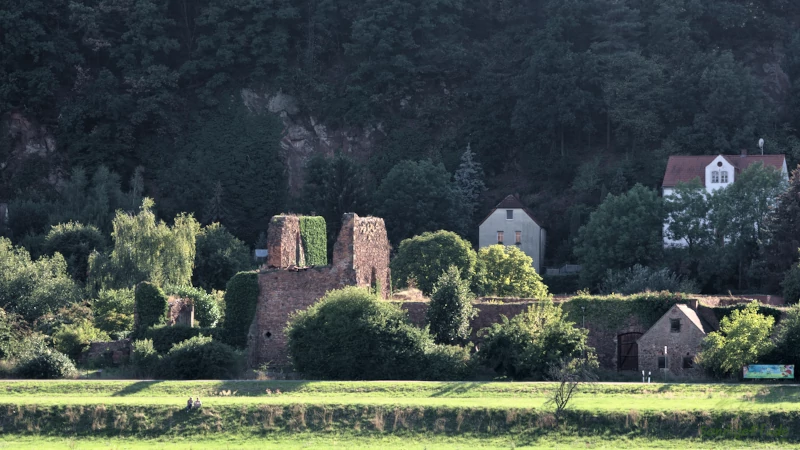
Arrival
The next airport to Meissen is Dresden airport or a little more far Leipzig – Halle airport (LEJ). There you get all services like rental car * or train connections*.
By bicycle to Meißen
Since the porcelain city is located about 25km north of Dresden on the Elbe River, the most beautiful travel recommendation is the Elbe Cycle Path. If you are coming from the north – south of Riesa (train station), the most beautiful section of the Elbe Cycle Path in Saxony’s Elbe Valley begins at Diesbar Seußlitz. And that’s where Meißen is located.
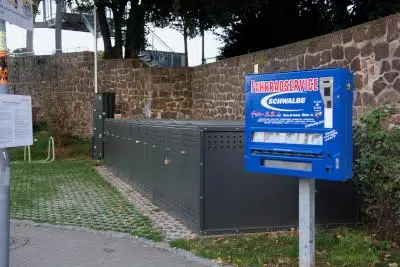
tube vending machine near Kändlerpark
For cyclists on the Elbe Cycle Path a tip: At the western end of the Old Town Bridge below the small Kändlerpark and again at the Roßmarkt left next to the large public toilet house you will find lockable bike boxes. You can put a whole packed bike in there, including luggage. The use is free of charge, you only need a € coin or shopping cart chip so to speak as a deposit for the key. So you can enjoy the city stroll and the museums or churches carefree – your luggage is dry and safely stowed! At the Old Town Bridge there are also bicycle tools, an air pump, a tube – vending machine and a charging station 220V for batteries (with your own charger) available, one of the bike boxes also has power connection for pedelecs.
By train
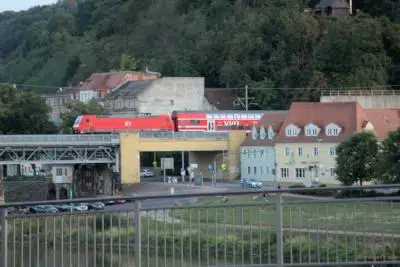
The easiest way to get to Meißen by train* is via Dresden. The Dresden S – train line S1 runs north to Meißen Triebischtal (terminus). From there you can easily walk back to the porcelain manufactory. Otherwise get off in Meißen Altstadt (old town). The main station of Meißen is on the right side of the river Elbe in Cölln. To get from there to the old town, you can either walk across the railroad bridge or across the old town bridge (car traffic).
Tip: If you are vacationing in Saxon Switzerland and want to get to the city and culture quickly, you can take the S1 suburban train directly from the mountains to Meißen, in addition to Dresden. The terminus of the S1 train in southern direction is located in Schöna and thus at the gateway to Bohemian Switzerland (ferry to Hrensko, Czech Republic).
By car
To get to Meißen by car, take the A4 freeway (Chemnitz – Dresden exit Wilsdruff – S177) or the A14 (Leipzig – Dresden, exit Nossen Ost) and the B101. An alternative of the more leisurely kind is the good old F6 (now B6) street from Leipzig to Dresden, which passes Meißen parallel to the Elbe. Rental cars* are available in Dresden as well as in Leipzig in the city center and at the airports.

Parking spaces are available in Meißen mainly next to the Elbuferstraße (B6). There below the castle hill directly on the Elbe are also caravan – parking spaces to find. The idyllic location on the riverbank meadows of the Elbe makes the place for motor home* – fans one of the most popular caravan – sites in the Elbe Valley.
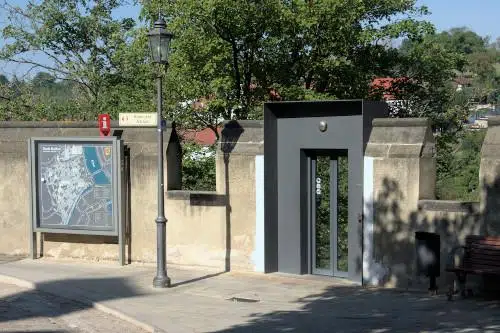
As described above, there is also a parking deck in Meisastraße, from which the panoramic elevator to Albrechtsburg Castle can be reached even by visitors with limited mobility (parking deck Meisastraße).
By steamboat to Meißen on the Elbe River
For the more adventurous, there is another way to get to Meissen as it was 100 years ago – by steamboat.
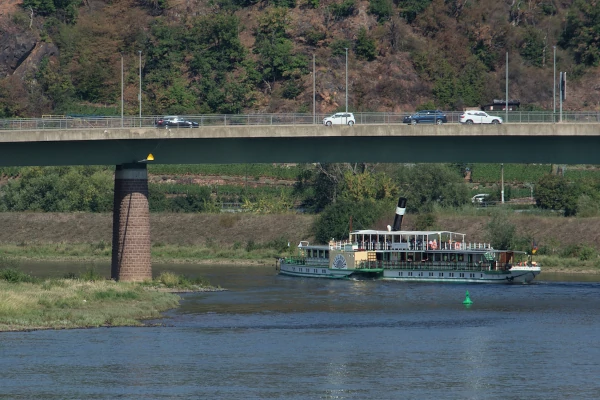
Meißen is located on the Saxon wine route and the Dresden White Fleet operates a wine route – line, which is driven by the paddle wheel – steamers. So you can choose the steamboat at least for one stretch from or to Meissen and if necessary flexibly return with the S train. Or later still to the baroque castle in Diesbar Seußlitz.
Accommodation in Meissen – hotels and guesthouses
Meißen offers a variety of accommodations. These are often located in historic old town houses and allow their guests to immerse themselves in the long history of the city, so to speak, around the clock. Nevertheless, one does not have to do without comfort. Only the journey, for example, to the castle hill is sometimes a little more difficult than in modern houses on the outskirts. Although – the Meissen city bus line, the elevator to the Burgberg and the pedestrian-friendly city center streets make even a hotel in the old town an intense Meissen experience.
Hotels in Meissen
Sometimes the view from across the river is especially appealing. The ****Wellnesshotel Goldenes Faß* is located on the right side of the river and presents the lazy flowing Elbe, the view over the old town and the castle hill with Albrechtsburg as a wonderful panorama. For the recovery of cobblestone-weary Meissen – visitors are available in the hotel extensive wellness – offers such as sauna, steam bath, massages and body treatments as well as food offers from regional and organic production. Travelers on the Elbe Cycle Path will find safe storage facilities in the hotel’s bike shed for their bikes. All rooms have tea and coffee facilities.
In the middle of the old town of Meißen guests can stay at the ****Romantik Hotel Burgkeller Kerstinghaus*. This hotel also offers various wellness facilities such as a Turkish steam bath, sauna and whirlpool as well as a fitness center. Some rooms have a view of the Albrechtsburg, the cathedral or the Elbe valley. Partially, the hotel is adapted to guests with mobility impairments. The house also offers Meissen wines from the Elbe Valley.
Also in the Old Town on Heinrichplatz, right next to the Meissen City Museum, the Hotel Goldener Löwe* (Golden Lion) offers a wide variety of rooms for individuals to families. A restaurant in the house offers local wines from the Elbe Valley. Bicycles can also be rented at the hotel for a fee. The hotel offers packed lunches for meals on your excursions.
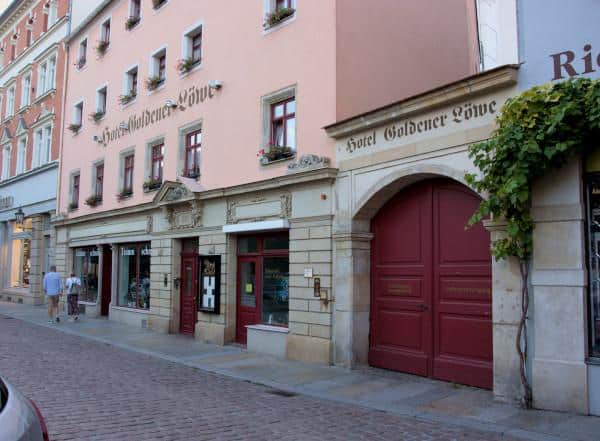
Guest houses and vacation apartments in Meißen
Visit Meissen and live like the canons on the castle hill! The vacation apartment in the Domherrenhaus* makes it possible. Feel transported to the 14th century (without TV 😉 ) and enjoy the view of the old town. The apartment for 2 persons is equipped with a kitchen (with modern appliances including washing machine) and bathroom. Parking (free of charge, narrow gateway) is available.
Several apartments of different sizes are offered by Sächsischer Hof* in the old town of Meissen, including rooms suitable for families. All apartments also have a suitable kitchen for simple catering. Pets are allowed. Parking is available at the accommodation.
Overnight accommodation with a good breakfast is offered by Pension Burkhardt* in Meissen Old Town for one to four guests. For cyclists, the pension has a lockable bicycle storage. Pets are allowed. The guesthouse does not provide its own parking facilities.
The Schönitz* guesthouse* is located in an old villa with a view of Meissen’s Old Town. A breakfast is part of the accommodation offer. Coffee and tea facilities can be found in all rooms at the guest house. The garden with a fireplace can be used as well. Parking is available at the house, including charging station for e-cars. The guest rooms are located on the ground floor and are therefore easily accessible for guests with limited mobility.
Just outside Meißen, the Rittergut Rottewitz* offers accommodation for up to 2 guests. The guesthouse is located about 2km from Albrechtsburg Castle on a right Elbe plateau above the Elbe valley and allows, in addition to visiting the city of Meißen, hikes through the vineyards on the Elbe. The operators lend bicycles to guests on request.

Already in the porcelain – fever?
Did you like the article, just invite your friends to visit Meissen! A link to the post in your social media channels will certainly whet your appetite for the trip. Positive feedback on good articles on the Internet helps search engines to separate the „wheat from the chaff“ and to present better search results to others – thank you!
Finally, and as a summary, here is a small „Meissen FAQ„:
The porcelain city of Meissen is located on the Elbe River in East german Saxony, about 25 km northwest of Dresden.
Meissen was founded as a castle by the East Frankish King Henry the 1st in 929, making it almost 1100 years old. Actually, the place is probably even older, because there was already a Slavic settlement Meisa at the foot of the castle hill.
The Elbe river flows through Meißen, and the Triebisch joins the Elbe in Meißen.
Meissen is best known for porcelain under the sign of the blue swords, that is, for the Royal Saxon Porcelain Manufactory. This is where the European version of porcelain was invented! Many visitors also keep in mind the image of Meissen with Albrechtsburg Castle and the cathedral above the Elbe River.
The hallmark of Meissen porcelain is two slightly curved blue swords crossed at an acute angle, with the points pointing upward.
Even getting there can be an experience – by paddle steamer on the Elbe river! Meissen attracts visitors primarily with a beautiful old town on the left bank of the Elbe, as well as with the climb to the castle hill of Albrechtsburg Castle. There you can visit the cathedral as well as the museum in the Albrechtsburg. Of course, the porcelain city on the Elbe also has a porcelain museum with an exhibition and show workshops. Themed trails also lead along „porcelain paths“ through Meissen. Other museums include the Thürmer Pianoforte Museum and the Patrician House (Webergasse 1). In the former monastery church of the Franciscans there is a city history museum, at the market an art exhibition. Several artists‘ studios welcome interested visitors.
Reference to * advertising – links
Some links in the article are marked with *. These are advertising links to stores or agencies. If you follow the link and buy or order something in the store, the sunny trails – blog receives a small commission to cover technical expenses. Nothing will be more expensive for you, because the commission is already included in the price.
Image source: Product images – Manufacturer / Dealer

